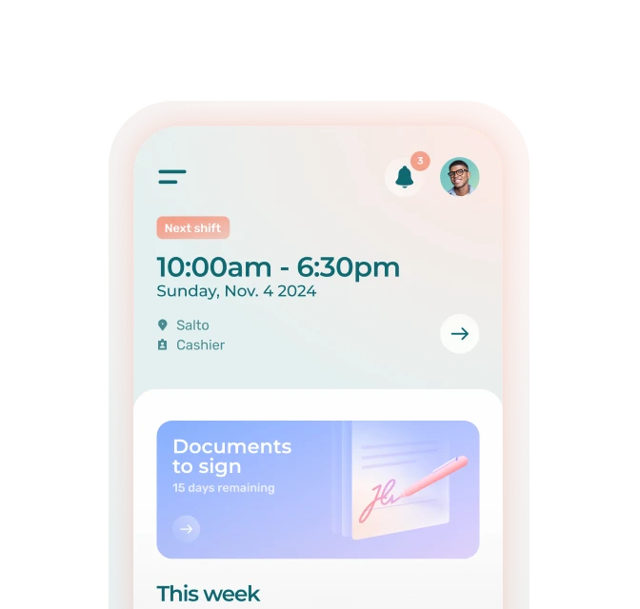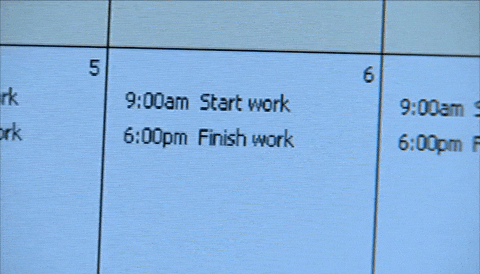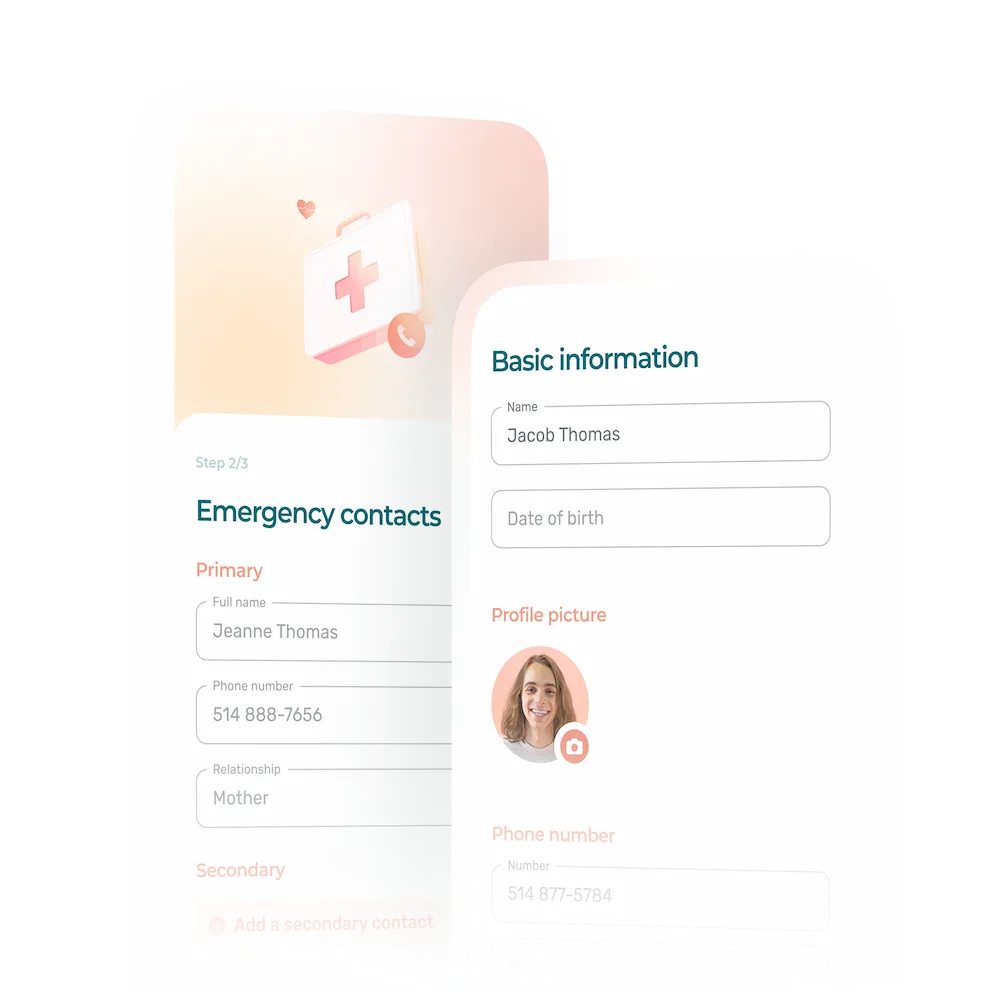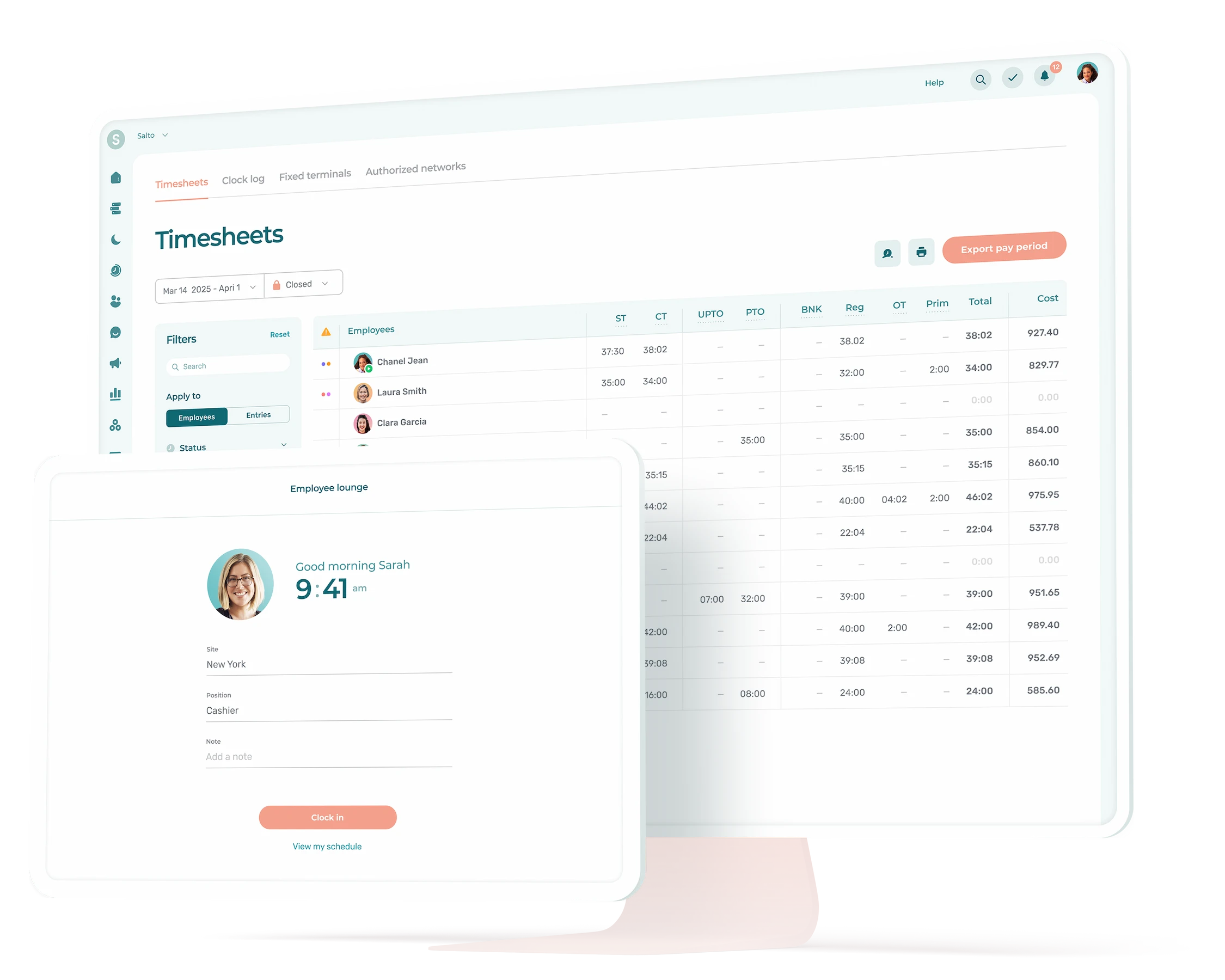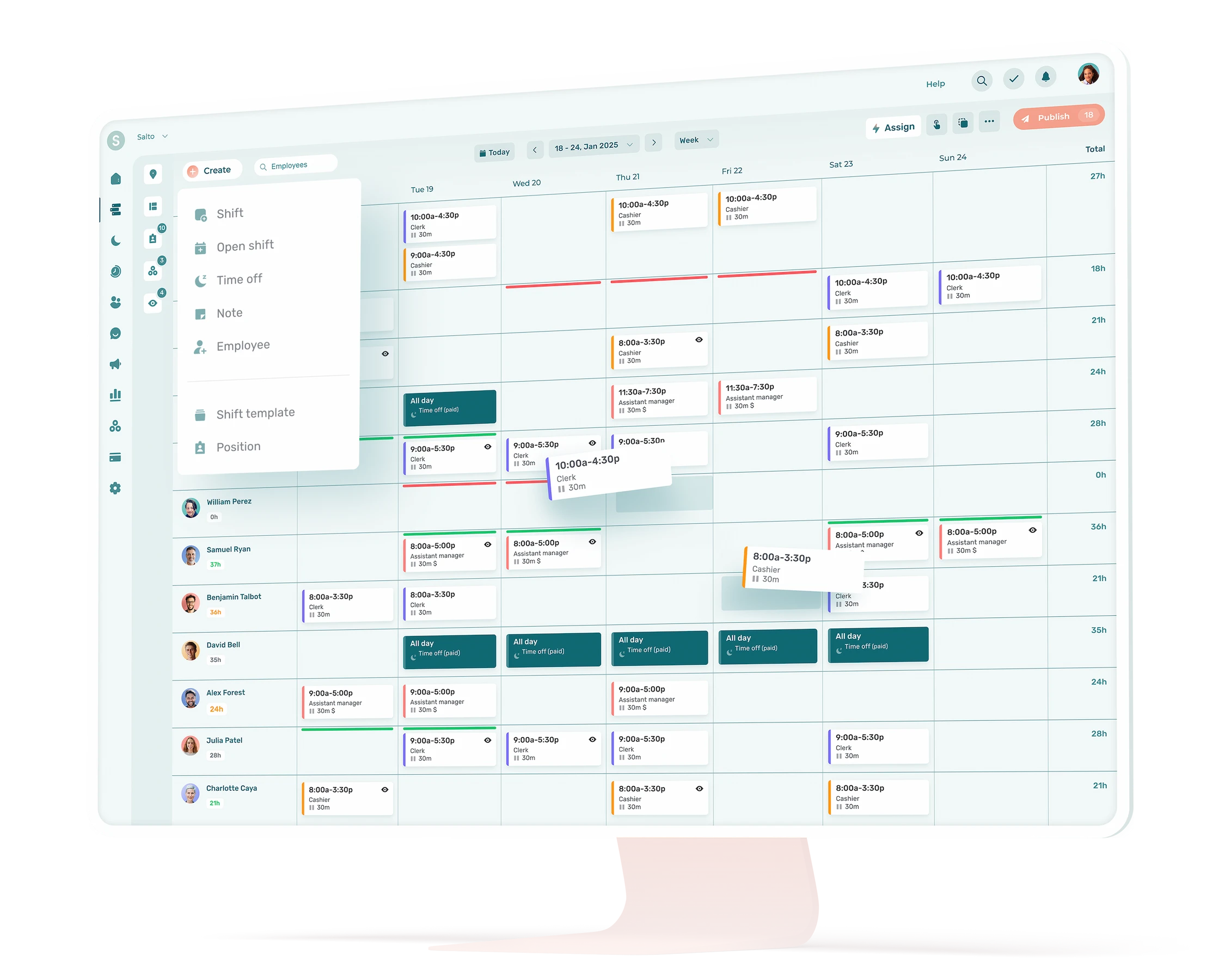Managing Late for Work Excuses: 25 Common or Cringeworthy Reasons Employees Give
Key takeaways
- Late-for-work excuses are universal, but manageable. From traffic jams to “my cat slept on my uniform,” these 25 real-life excuses reveal how common lateness issues are across all industries.
- Clear policies prevent losing control. Define how and when employees should report lateness or absences, and make sure everyone knows the rules to avoid misunderstandings.
- Track and analyze patterns. Distinguish one-off delays from recurring issues to ensure fairness and maintain team morale.
- Use HR and scheduling software. With tools like Agendrix’s time and attendance app, managers can automate shift coverage, centralize communication, and reduce absenteeism.
Ah, the infamous late for work excuses every manager has heard at some point. From alarm clocks that “didn’t go off” to mysteriously vanished transit passes, here are 25 excuses that’ll make you laugh…or sigh in disbelief.
No matter how amusing or frustrating they sound, these excuses all point to the same need: improving how managers handle lateness and absences. So along with our top 25 list, equal parts funny and eye-opening, you’ll also find practical tips to keep things on track.
Late for Work, Again?
In the middle of a busy shift, getting a last-minute call from an employee saying they’ll be late—or worse, not showing up at all—is never a small thing. So when it happens on a Saturday night right before the dinner rush at a restaurant, or during the peak of vacation season as guests line up to check in at a hotel, stress can get off the charts.
For managers, these surprises quickly turn into mental gymnastics: reshuffling the schedule, calming the rest of the team, and still delivering great service no matter what. If employees being late for work is something you’re dealing with regularly, you’re definitely not alone:
- Over half of managers and employees say absenteeism negatively impacts their well-being, and 71% report taking on a heavier workload because of it. (Workforce Trends Report 2024–2025, Leapsome)
- Nearly 50% of absences need to be covered by overtime (Total Financial Impact of Employee Absences in the U.S., SHRM)
Beyond the stress, these situations mean lost time. And also often, lost revenue.
Excuses for Being Late for Work: 25 Real-Life Gems We’ve Heard
The following examples are all real excuses, collected from a range of industries: restaurants, retail, pharmacies, grocery stores, tourism, healthcare, and more. Chances are, you’ve heard a few of them yourself.
Logistics and Health-Related Late for Work Excuses
Some excuses are understandable, even legitimate. But they always seem to happen at the worst possible time: traffic jams, a sudden stomach bug, or a faulty alarm. These are common and often unavoidable, but they still create major headaches for managers.
1. “I took the wrong exit on Highway 401 and somehow ended up in Kitchener.”
– Hotel employee in Southwestern Ontario.
2. “I missed my bus, and the next one wasn’t for 45 minutes.”
– Retail worker at a shopping mall.
3. “My car wouldn’t start this morning because of the cold.”
– Hotel front desk agent, in the middle of winter.
4. “My kid messed with my alarm and set it for 10 p.m. instead of 7 a.m.”
– Shift worker at a ski resort.
5. “I got stuck in traffic after a construction detour.”
– Pharmacy employee during rush hour downtown.
6. “I lost my bus pass / my pass had expired.”
– Student working as a dishwasher in a restaurant.
7. “I was supposed to carpool with a coworker, but they never showed up and I didn’t have a ride.”
– Seasonal restaurant employee.
8. “I didn’t hear my alarm.”
– Pharmacy employee scheduled for the morning opening shift.
9. “I think I’ve got a stomach bug, I’d rather not risk making everyone sick.”
A classic excuse in any industry… and honestly, no one wants to test that theory. 🤢
The Most Ridiculous Late for Work Excuses We’ve Heard
These? We couldn’t make them up if we tried. They go to show just how creative some employees can get when trying to justify being late. Creativity: 10/10. Professionalism? Up for debate.
10. “I got stuck in the bathroom. The door handle broke.”
– An employee truly caught off guard.
11. “My roommate left with my shoes without telling me. I didn’t have another pair.”
– Grocery clerk.
12. “My neighbor blocked my car in by parking sideways.”
No car, no shift. 🤷♀️
13. “I was stuck in the Tim Hortons drive-thru line and it just wasn’t moving.”
Heard at a convenience store at 6 a.m.
14. “I was trapped in a dream and couldn’t wake up.”
– Fast food worker on the night shift.
15. “I had an interview for another job.”
– Pharmacy cashier.
16. “I forgot today was Thursday.”
Actually said… on a Thursday.
17. “There was a movie set on my street and I couldn’t leave my house.”
– Downtown Toronto employee.
18. “I had an audition for Love Island Canada: I think I nailed it and will make it to the next round!”
– Clothing store employee.
19. “My cat slept on my uniform, and I didn’t have a clean one… so I had to do laundry.”
– Restaurant employee with a strict dress code
Schedule-Related Late for Work Excuses
Miscommunication around work schedules is one of the top reasons for lateness. A misread schedule, a forgotten shift swap, or someone showing up at the wrong location. These are the kind of reasons for being late for work that really shouldn’t happen anymore, but somehow still do.
20. “I misread the schedule. I thought I started at 4 p.m., not at 2 p.m.”
A classic, especially if not using an employee scheduling software.
21. “I thought someone had taken my shift.”
A common misunderstanding with paper-based shift swaps.
22. “I checked the schedule during my last shift and didn’t see the change.”
Often happens when using printed schedules instead of dynamic, up-to-date schedules with change notifications.
23. “I had requested the day off but just noticed I’m still on the schedule.”
A mix-up or miscommunication. In any case, the employee’s not at work.
24. “I was at work, just at the wrong location.”
Typical for staff who rotate between different branches.
25. “I forgot I had swapped shifts with someone.”
Pharmacy employee with a rotating schedule.
How to Respond (Rationally) to Late for Work Excuses
Part of being a manager is becoming a collector of excuses. Some are perfectly valid, while others border on performance art. The goal isn’t to excuse everything—it’s to be consistent and proactive in how you handle it.
🧘♂️ Stay calm, but keep a record
It’s tempting to roll your eyes when someone says their dog ate their car keys. Still, no matter how bizarre the excuse, it’s important to stay professional and give the employee the benefit of the doubt. Without being naïve that is.
Listen, ask questions if needed, and document the absence. This not only helps you keep track of repeat issues, but also gives you a solid foundation if you ever need to take more formal action.
🔍 Know the Difference Between a One-Off and a Pattern
Everyone runs late once in a while. But when there’s a new excuse every week, it’s time to take a closer look.
Good absence management means spotting recurring patterns. Some employees might need support or adjustments; others may be taking advantage of unclear policies.
Have you set explicit ground rules, or is there room for interpretation? When nothing is formalized—not the expectations, not the consequences—people tend to make it up as they go. That ambiguity can lead to tension, a sense of unfairness, and total chaos when it comes to scheduling.
It also makes it hard to tell the difference between a one-time mistake and a recurring issue. That’s why a simple, well-defined policy on lateness and absences is key.
📜 Create a Clear Policy for Absences and Lateness
A clear, written policy on absences and lateness can help prevent a lot of misunderstandings. It should outline:
- How much notice is required for calling in late or absent.
- Which communication channels are acceptable (ex.: no 5 a.m. texts to your personal number).
- What disciplinary measures apply in cases of abuse.
- How shift replacements are handled, and who’s responsible for what.
When you share this policy with all employees, you set a standard everyone can follow. That consistency makes all the difference.
🧠 Use Scheduling Software to Track Absences and Simplify Shift Coverage
With time and attendance software, you always have a clear overview of absences, shift swaps, and team availability. No more digging through text messages or relying on your memory: everything’s in one place.
Employees can even request time off or report an absence or lateness directly in the app, sparing you those last-minute panic calls at the worst possible times.
When someone lets you know they can’t make their shift, the right time tracking tool lets you:
- Get an instant notification
- See who’s available to fill in
- Share the open shift with the team in one click
- Quickly assign the shift to the right person
Less chaos, more flexibility.
Managing Absences and Lateness with Agendrix
Many businesses have successfully improved how they handle absences by using the right tools. With Agendrix, organizations benefit from real-time notifications, quick and easy shift replacements, and centralized communication. So long, chasing scattered messages across different platforms.
Here’s how two very different workplaces, a convention center and a senior living residence, used Agendrix to bring more structure and peace of mind to their scheduling.
Reducing Absences Linked to Flexible Schedules at the Hôtel & Centre des congrès de Lévis
Managers at the Hôtel & Centre des congrès de Lévis used to face challenges with absenteeism and communicating schedules. Flexible working hours are part of the organization’s reality, they were therefore seeking a solution that could accommodate their situation.
Since adopting Agendrix, they’ve seen a real difference:
- Reduced absenteeism: employees now have access to up-to-date schedules, reducing unintentional no-shows.
- Better communication: automatic notifications keep everyone informed of schedule changes, avoiding any confusion.
Absenteeism is down, and employees aren’t wasting time accidentally showing up for shifts they’re not scheduled for. Clear communication, smooth operations.
Making the Most of Open Shifts at Villa Ste-Rose
Villa Ste-Rose, a senior living residence, transformed how it manages scheduling and absences with Agendrix:
- Faster shift coverage: the open shifts feature helps managers quickly handle absences and find replacements.
- Less absenteeism: giving employees the ability and autonomy to apply for shifts through the app has led to a noticeable drop in no-shows.
With the open shifts feature, absence management is quick and employees can apply for shifts right in the app. Absenteeism has dropped so much that we almost never need to call staffing agencies anymore!
Next Time the Alarm Doesn’t Go Off, Be Ready
Managing a team effectively requires more than resourcefulness and patience when someone calls in at the last minute.
By setting clear ground rules, encouraging open communication, and using the right scheduling tools, you’ll be better equipped to handle the unexpected. Turn chaos into quick fixes and make last-minute absences easier on everyone in your team, including yourself.
What Are the Most Common Excuses for Being Late for Work?
The most frequent excuses for being late for work usually involve traveling issues (car trouble, traffic, missed bus), logistics slip-ups (alarm didn’t go off, simply forgot), family situations (sick child, last-minute daycare problems), or minor health problems (stomach bug, food poisoning). These late for work excuses are often valid, but when there’s no clear structure in place, they can quickly become recurring.
Scheduling mistakes or misunderstandings are also extremely common. One missed shift, an unconfirmed shift swap, or a schedule that wasn’t checked in time—and suddenly someone shows up late, or not at all. This is especially true in workplaces with flexible schedules, where poor communication can easily create confusion.
How to Handle an Employee Who’s Often Late?
When an employee is regularly late, the key is to be consistent. Start by making sure your lateness policy is clearly communicated and enforced.
Then, keep track of absences and hold one-on-one meetings to understand what’s behind the issue. With proper follow-ups and a reliable time & attendance management tool like Agendrix, it becomes much easier to tell the difference between a one-time slip and an ongoing problem.
What Impact Does Being Late for Work Have on a Business?
Even a single instance of lateness can disrupt how a team functions, especially in industries like restaurants, retail, or senior care facilities.
The most common impacts include:
- Heavier workload for coworkers
- Delays or reduced service quality
- Increased stress for managers
- Team tension and frustration
- Long-term drops in productivity and job satisfaction
When lateness becomes a habit, it can seriously hold a business back. That’s why it’s so important to act early, track patterns, and use the right tools to prevent the unexpected from becoming the norm.
What Should a Good Lateness Policy Include?
A good policy on lateness and absences should be simple, clear, and known by every employee. It should outline:
- How much notice is required for reporting a late arrival or absence
- Which communication channels to use
- The consequences for frequent or unjustified lateness
- The procedure for finding a replacement, if applicable
This kind of policy can be included in the employee handbook or shared directly through a platform like Agendrix. What matters most is setting clear expectations to avoid misunderstandings, frustration, and perceived unfairness among team members.
How Does Agendrix Help Manage Lateness at Work?
Agendrix helps reduce lateness by giving employees 24/7 access to their schedules, sending automatic notifications when shifts change, and making it easy to quickly find replacements to avoid service disruptions. The manager dashboard shows real-time data on attendance, lateness, and breaks, so you always know who’s where.
Managers save time and gain clarity, while employees know exactly what’s expected of them. Plus, the built-in communication tool keeps all messages in one place, with a written record to back them up.


